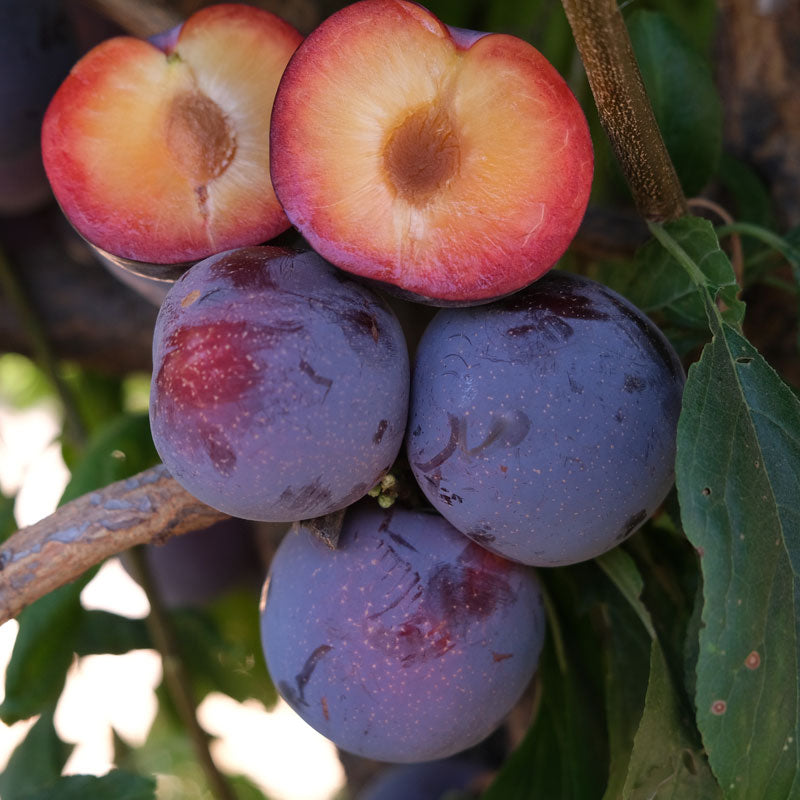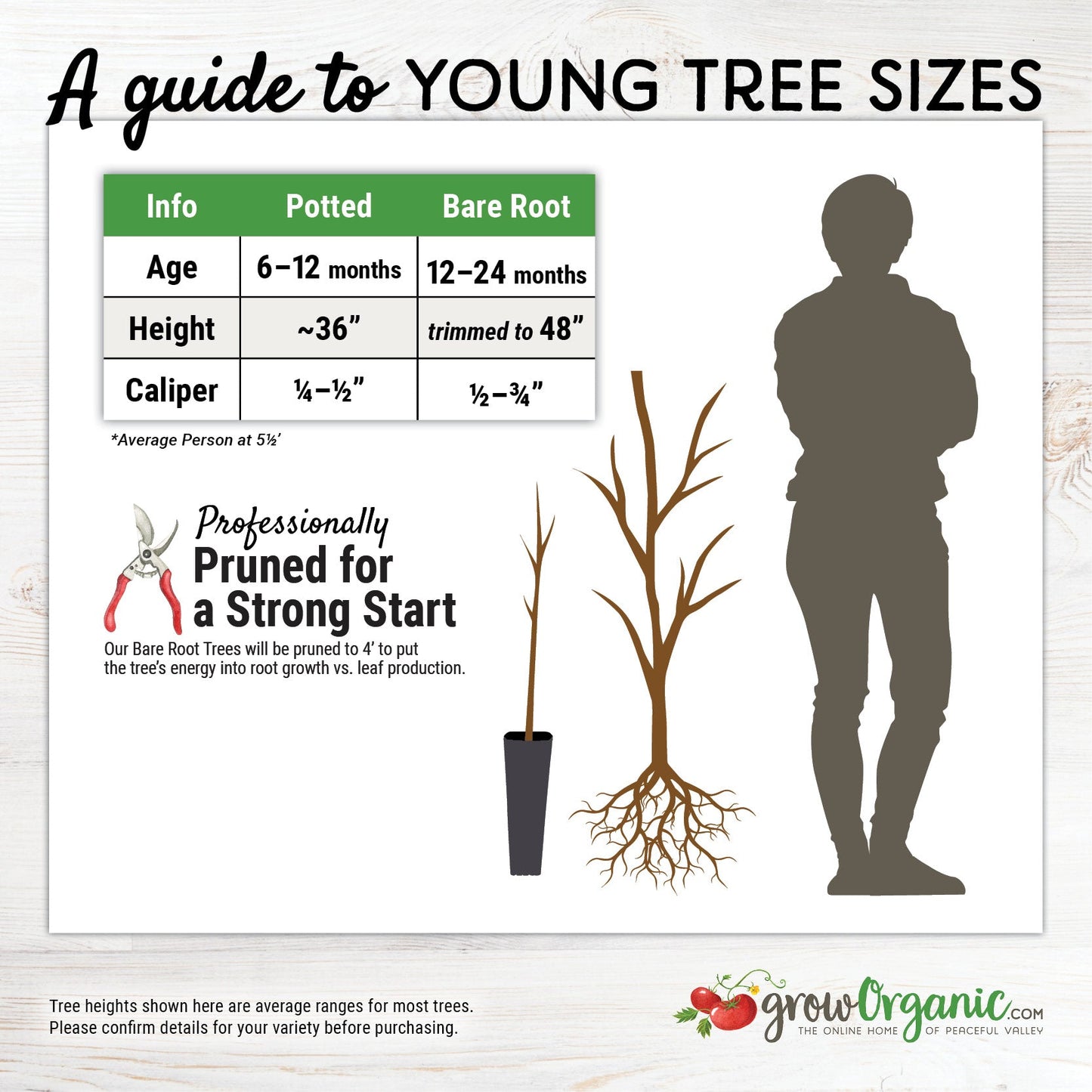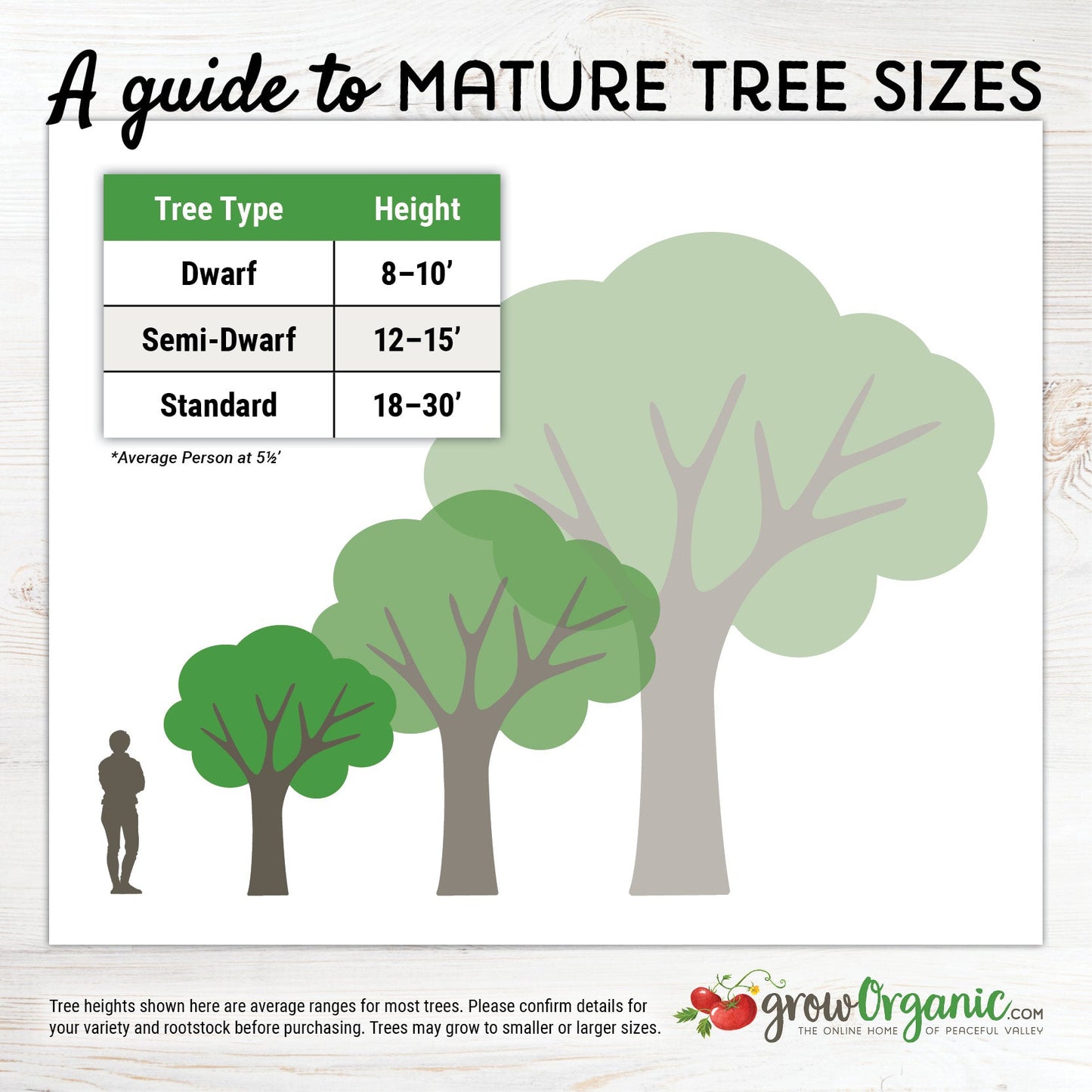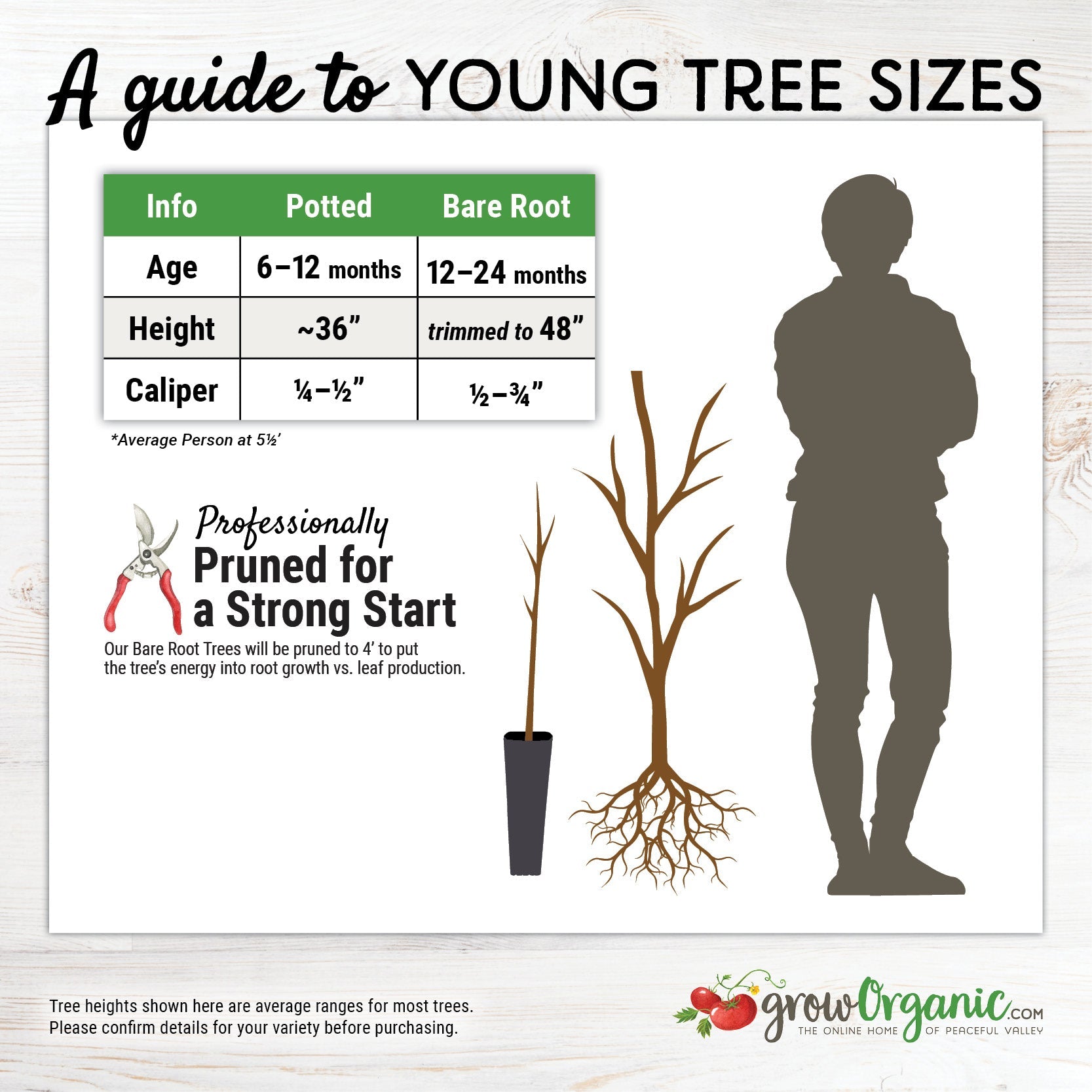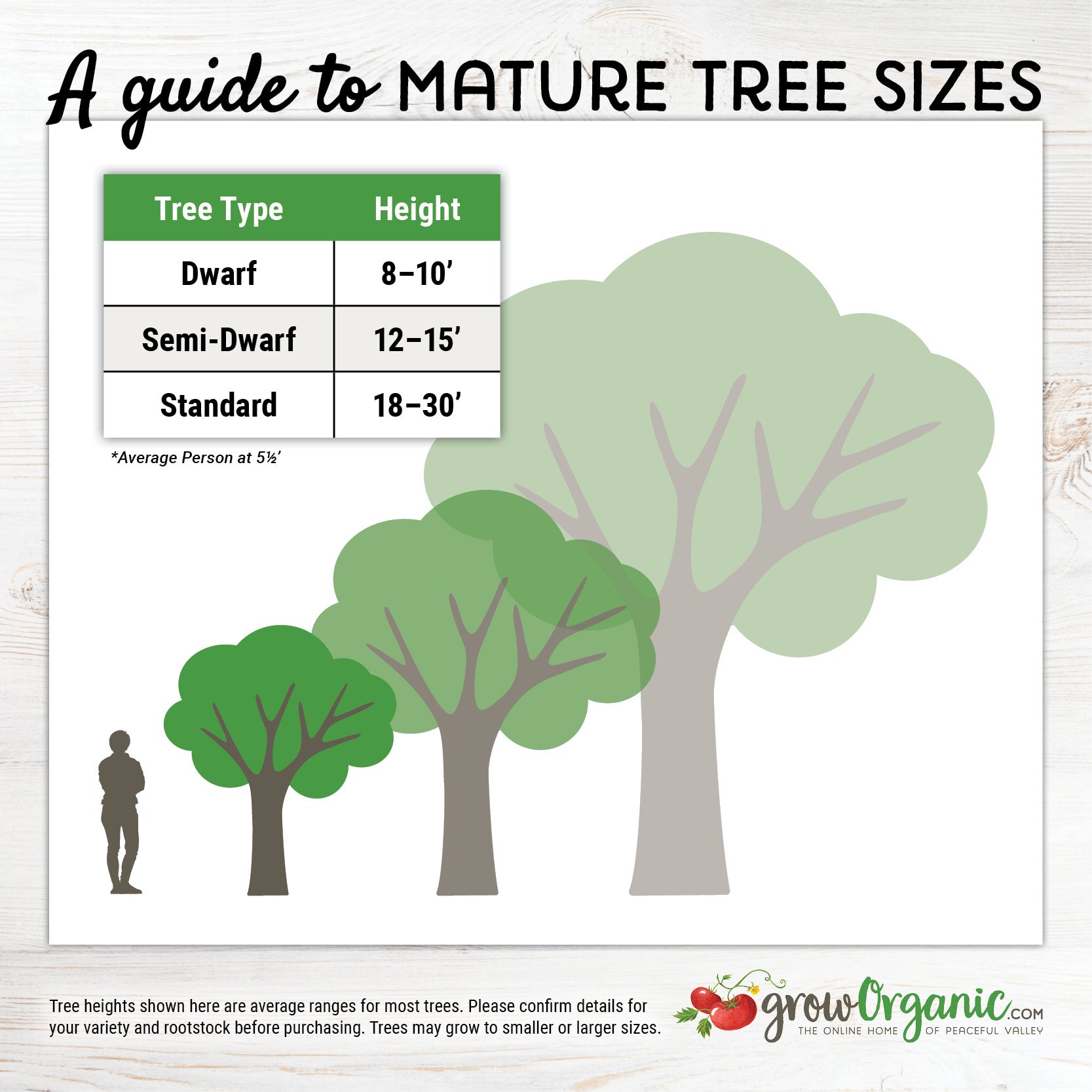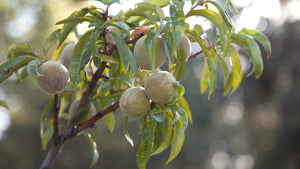Item Number: FT206
Laroda Plum Tree
Laroda Plum Tree
Best Flavor for Warm Climates
Semi-dwarf on Citation rootstock.
The Laroda Plum Tree stands as a pinnacle of flavor and suitability for warmer climates, offering sweet, juicy plums with a remarkable wine-like essence. Delve into the nuances of growing and nurturing this tree to enjoy a bountiful harvest of exceptional plums.
- Growing Zones: Ideal for zones 6-9.
- Chill Requirements: Needs about 400-500 chill hours for fruiting.
- Bloom Time: Late February to Early March
- Harvesting Dates: Generally harvested from July to August.
- Looks: The Laroda Plum has dark purple skin with red and amber flesh.
- Personality: Known for its excellent flavor, being juicy with an extraordinary wine-like taste.
- Facts of Note: Considered one of the best-tasting Japanese plums. Originated from a Santa Rosa x Gaviota cross, with a firm texture and high sweetness balanced with acidity. Often used for making jams, jellies, and fresh eating.
- Pollinator: Pollinated by Santa Rosa, Nubiana, Late Santa Rosa, or Burgundy plum varieties.
- Ideal Soil Temperatures: Thrives in temperatures around 60°F to 80°F (15°C to 27°C).
- Planting Depths: Plant young trees at the same depth they were growing in the nursery container.
- Germination Periods: Typically grown from grafted trees rather than seeds. Germination isn't applicable.
- Height at Maturity: Grows to a height of around 15-20 feet (4.6 to 6.1 meters).
- Days to Maturity: Starts producing fruit in about 2-3 years, with full maturity achieved in 5-7 years.
- Sun/Shade: Laroda Plums prefer full sun for optimal fruit production.
- Spacing After Thinning: Proper spacing is crucial; maintain a spacing of about 4-6 inches apart for healthy growth.
Best Suited for Warm Climates:
Thriving in Zones 6-9, the Laroda Plum Tree flourishes in full sun conditions. Its semi-dwarf nature on Citation rootstock makes it an ideal choice for smaller spaces or home gardens.
Chill Hours and Harvest Time:
Requiring around 400-500 chill hours, this tree blooms and bears fruit from July to August. Its appearance is characterized by dark purple skin enveloping red and amber flesh, offering a delightful visual and flavorful treat.
Extraordinary Flavor Profile:
Renowned for its exceptional flavor, Laroda plums are considered among the best-tasting Japanese plums. Originating from a cross by Dr. Claron O. Hesse, it boasts a wine-like essence that pairs high sweetness with a balanced acidity, delivering an unparalleled taste.
Origin and Characteristics:
Developed as a Santa Rosa x Gaviota cross in 1943 and introduced in 1954, Laroda inherits its dark skin from Santa Rosa with amber flesh adorned by red streaks. Its texture leans toward firmness, elevating its suitability for fresh consumption, jams, and jellies.
Cultivation and Growth:
The tree exhibits tight, upright growth patterns, making it an excellent choice for smaller spaces or home gardens. Its manageable size, coupled with proper pruning techniques, allows for easy maintenance and control, especially when kept below 10 feet through summer pruning.
Pollination Requirements:
To ensure optimal fruit set, the Laroda Plum Tree requires suitable pollinators such as Santa Rosa, Nubiana, Late Santa Rosa, or Burgundy. Planting these compatible varieties nearby promotes cross-pollination and enhances fruit production.
Versatility in Use:
Laroda plums are versatile, ideal for both fresh eating and culinary purposes. Their exceptional flavor makes them a delightful choice for jams, jellies, and other culinary creations.
Cultivating a Laroda Plum Tree requires attention to its preferred growing conditions, ensuring full sun exposure and proper pollination. With its exceptional flavor and adaptability to warm climates, this tree stands as an excellent choice for home gardeners seeking delectable, sweet, and juicy plums.
Visit our Fruit Tree Central for a listing of all our fruit tree videos and articles.
Visit Tree Characteristics for a listing of all our fruit & nut tree growing characteristics.


Check Your Zone Compatibility:
Compatible with your zone.
Growing Zone for
,

Our Guarantee To You
Since 1976, we've served our customers at every stage of growing. Please contact us at any time. We are happy to support and assist you.
Description
Description
Semi-dwarf on Citation rootstock.
The Laroda Plum Tree stands as a pinnacle of flavor and suitability for warmer climates, offering sweet, juicy plums with a remarkable wine-like essence. Delve into the nuances of growing and nurturing this tree to enjoy a bountiful harvest of exceptional plums.
- Growing Zones: Ideal for zones 6-9.
- Chill Requirements: Needs about 400-500 chill hours for fruiting.
- Bloom Time: Late February to Early March
- Harvesting Dates: Generally harvested from July to August.
- Looks: The Laroda Plum has dark purple skin with red and amber flesh.
- Personality: Known for its excellent flavor, being juicy with an extraordinary wine-like taste.
- Facts of Note: Considered one of the best-tasting Japanese plums. Originated from a Santa Rosa x Gaviota cross, with a firm texture and high sweetness balanced with acidity. Often used for making jams, jellies, and fresh eating.
- Pollinator: Pollinated by Santa Rosa, Nubiana, Late Santa Rosa, or Burgundy plum varieties.
- Ideal Soil Temperatures: Thrives in temperatures around 60°F to 80°F (15°C to 27°C).
- Planting Depths: Plant young trees at the same depth they were growing in the nursery container.
- Germination Periods: Typically grown from grafted trees rather than seeds. Germination isn't applicable.
- Height at Maturity: Grows to a height of around 15-20 feet (4.6 to 6.1 meters).
- Days to Maturity: Starts producing fruit in about 2-3 years, with full maturity achieved in 5-7 years.
- Sun/Shade: Laroda Plums prefer full sun for optimal fruit production.
- Spacing After Thinning: Proper spacing is crucial; maintain a spacing of about 4-6 inches apart for healthy growth.
Best Suited for Warm Climates:
Thriving in Zones 6-9, the Laroda Plum Tree flourishes in full sun conditions. Its semi-dwarf nature on Citation rootstock makes it an ideal choice for smaller spaces or home gardens.
Chill Hours and Harvest Time:
Requiring around 400-500 chill hours, this tree blooms and bears fruit from July to August. Its appearance is characterized by dark purple skin enveloping red and amber flesh, offering a delightful visual and flavorful treat.
Extraordinary Flavor Profile:
Renowned for its exceptional flavor, Laroda plums are considered among the best-tasting Japanese plums. Originating from a cross by Dr. Claron O. Hesse, it boasts a wine-like essence that pairs high sweetness with a balanced acidity, delivering an unparalleled taste.
Origin and Characteristics:
Developed as a Santa Rosa x Gaviota cross in 1943 and introduced in 1954, Laroda inherits its dark skin from Santa Rosa with amber flesh adorned by red streaks. Its texture leans toward firmness, elevating its suitability for fresh consumption, jams, and jellies.
Cultivation and Growth:
The tree exhibits tight, upright growth patterns, making it an excellent choice for smaller spaces or home gardens. Its manageable size, coupled with proper pruning techniques, allows for easy maintenance and control, especially when kept below 10 feet through summer pruning.
Pollination Requirements:
To ensure optimal fruit set, the Laroda Plum Tree requires suitable pollinators such as Santa Rosa, Nubiana, Late Santa Rosa, or Burgundy. Planting these compatible varieties nearby promotes cross-pollination and enhances fruit production.
Versatility in Use:
Laroda plums are versatile, ideal for both fresh eating and culinary purposes. Their exceptional flavor makes them a delightful choice for jams, jellies, and other culinary creations.
Cultivating a Laroda Plum Tree requires attention to its preferred growing conditions, ensuring full sun exposure and proper pollination. With its exceptional flavor and adaptability to warm climates, this tree stands as an excellent choice for home gardeners seeking delectable, sweet, and juicy plums.
Visit our Fruit Tree Central for a listing of all our fruit tree videos and articles.
Visit Tree Characteristics for a listing of all our fruit & nut tree growing characteristics.
About Plums: Plums are not generally self-pollinated and can be tricky to grow in areas with late frosts but are superb for fresh eating. They are the favored fresh eating varieties in the United states being larger, firmer fleshed, and rounder than European plums. Japanese plum trees have rougher bark, more persistent spurs, and more numerous flowers than European plums. They are also more precocious, disease resistant, and vigorous than European plums. Japanese plum flavor ranges from sweet to tart. Browse all our plum trees for sale.
Please Note: Although most of our bare-root trees arrive to our warehouse in mid-December, there are a few varieties that will not arrive until mid-January. If you order any of those varieties along with varieties that arrive in mid-December, your order will be delayed for shipment until mid-January. If you'd like us to split your shipments, please contact us at (888) 784-1722 or orderdesk@groworganic.com. Additional shipping charges will apply.
Shipping Information
Shipping Information
Cannot ship to the following states: HI, AK, PR, GU, VI
Cannot ship via USPS.
Cannot ship via SmartPost.
Shipping Weight: 5.0 lb
Dimensions: 55.5"L x 7.3"W x 2.75"H
Features
Features
- Flavor Pick
- Suited to Warmer Climates
Characteristics
Characteristics
Planting & Care
Planting & Care
Useful Information
Useful Information
Guarantee
Guarantee
Limited Dormant Tree & Plant Guarantee
* Claim deadline is June 15th
We guarantee that your dormant tree or plant will arrive in good, viable condition. If your tree arrives in substandard condition, notify us within 3 days of delivery. Please email pictures of the box, inside packaging, the tree and its roots to helpdesk@groworganic.com. We will investigate your claim and process a request to exchange or refund the damaged product.
If your dormant tree or plant has not grown new leaves by June 15th, you may be eligible for our Limited Dormant Tree & Plant Guarantee. This guarantee provides for a store credit for the purchase price of the tree, excluding shipping. Please see the Instructions below.
Important Dates:
- April 1st Dormant trees/plants must be planted in the ground
- May 15th Perform scratch test, if no new leaves have grown
- June 15th Deadline to apply for a dormant tree/plant credit
All required documentation must be received by June 15th for your claim to be considered. Claims or documentation received after June 15th will be denied, without exception. Instructions listed below
Terms and Conditions
We cannot guarantee that your tree or plant will remain alive and healthy after it is received, or bear fruit as there are too many variables in your environment that are beyond our control (i.e. soil preparation, weed and pest control, proper irrigation, chill hours, compatible hardiness for your growing zone, proper choice of pollinator, extreme weather, rodent damage, disease, etc.).
We cannot guarantee that we will be able to provide a replacement tree/plant of the same species either that same growing season or in future years. Customers are responsible for all shipping fees associated with replacement trees and plants.
If we determine that the tree you purchased directly from us is not viable, we will issue you a store credit (not a refund) for the purchase price of the affected dormant tree or plant. Shipping is not included in the dormant tree/plant guarantee. Store credits can be used to purchase any product we sell and are valid for use only until July 1st of the following year.
Historically, 98% of our dormant trees and plants grow and thrive when they have been cared for and planted using our growing guides. Dormant trees and plants must be planted in the ground by April 1st in order to be eligible for credit. If the ground in your area is still frozen solid, you may temporarily plant your tree or plant in a pot.
Potted, non-dormant trees or plants are excluded from this guarantee as they are not dormant at the time of shipment. Evergreen trees such as citrus, avocado and olive trees are not available for credit under the Dormant Tree and Plant Guarantee.
Instructions
We guarantee that your dormant fruit tree or plant will leaf out, if you care for it according to our growing guides. In the unlikely event that your dormant tree or plant does not have leaves by May 15th, follow these simple steps to apply for a store credit:
Before you call or email, please perform a “scratch test” to determine if the tree or plant is still alive. This video shows how to check for live tissue under the bark. Scratch tests need to be done a few inches above and below the graft.
Green Cambium Layer / Living Trees
If the cambium layer under the bark is green, give your tree a little more time. It is still alive, but hasn’t come out of dormancy yet. Check to make sure that it is getting the right amount of deep root water, enough sunlight and that the weather is warm enough for that type of tree/plant to come out of dormancy. Every tree has its own personality and will come out of dormancy at different times. Be sure to submit the required documentation listed below by June 15th, if it doesn’t grow leaves.
Brown Cambium Layer / Dead Trees
If the scratch test shows a brown cambium layer or if your dormant tree/plant doesn’t have leaves by June 1st, please email us at helpdesk@groworganic.com. All required documentation listed below must be received by June 15th for your claim to be considered. To be considered for the guarantee claim, all required documentation must be received by June 15th. Incomplete submissions will be denied.
Required Documentation
- Order number
- Name of dormant tree/plant and the quantity affected
- Photos of each tree or plant showing:
- The roots (tree or plant must be pulled out of the ground)
- The scratch test areas
- The entire tree/plant
We reserve the right to not issue credit for items that have already been replaced. We also reserve the right to require photographic evidence that the tree/plant was not killed by root rot, rodent or mechanical damage.
Share
